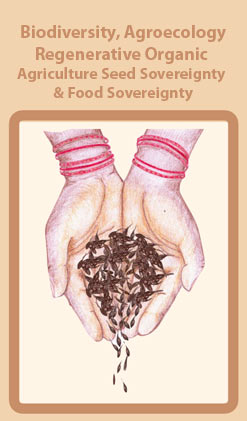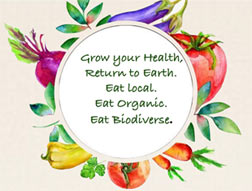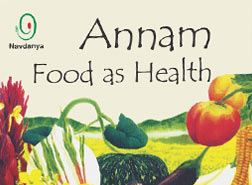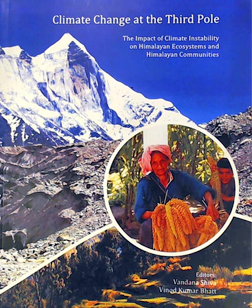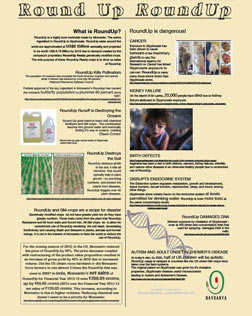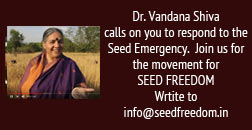ANNA SWARAJ (Food Sovereignty) 2020:
AN AGENDA FOR FREEDOM FROM HUNGER , MALNUTRITION , DISEASE and FARMERS SUICIDES
A message for Independence Day 2015
By Dr Vandana Shiva
There is no reason why India should face hunger and malnutrition, and why our farmers should commit suicide. India is blessed with the most fertile soils in the world.Our climate is so generous we can in places grow 4 crops in a year, compared to only one in most of the industrialised west. We have the richest biodiversity of the world , both because of our diverse climates , and because of the brilliance of our farmers as breeders. And our farmers are among the most hardworking productive in the world. Yet India faces an emergency in our food and agricultural system. This emergency is manmade .
Firstly , the poor and vulnerable are dying for lack of food . According to the Deccan Herald Lalita S. Rangari, 36, a Dalit widow and mother of two children of the Gondiya tribal belt allegedly died due to starvation. Bombay High Court-Nagpur Bench comprising Justice Bhushan Gavai and Justice Indu Jain served notice to Maharashtra government seeking its reply to the starvation death of a Dalit widow reported from
Even as India gets richer , we have emerged as the capital of hunger and malnutrition . According to the National Family Health Survey (NFHS), 42.5% of children under five years old were underweight. This is more than double the average of 21% for Africa which until recently was the face of hunger.
The second tragedy is that our food producers , the small farmers who have provided food to more than a billion Indians , and hold the potential to provide healthy food for all, are themselves dying because of agriculture and trade policies which put corporate profits above the rights and well being of our small farmers .More than 300,000 farmers have committed suicide in India since 1995, when the rules of globalization of agriculture of the WTO were implemented, transforming food into a commodity, agriculture into corporate business ,and shifting control over seeds and food from farmers to giant multinational corporations .
The third tragedy is that even those who get food are being denied their right to healthy and nourishing food. The explosion of junk food, of pesticides and toxics in our food have created a disease epidemic that is a human tragedy, and an economic burden. There is an epidemic of diseases related to our lifestyle and food such as diabetes, cancer, hypertension, infertility and cardiovascular diseases .
The recent Maggi noodle scandal highlights the rapid invasion of junk food in the Indian diet.
We are what we eat . When we eat food full of toxic chemicals, we pay the price with our health .
India has emerged as the epicentre of Diabetes
In 2004 8.2 lac were diagnosed with diabetes and 2.6 died
in 2012 180 lac were diagnosed and 7 lac died
In 2010 India was spending 32 billion dollars on diabetes care.
Cancer has seen a 30% increase in last 5 years with 180 million people affected in India. At 10 lac treatment per cancer victim this multiplies to 300 billion dollars which is 18 lac crores.
In extensive studies reported in “Poisons In Our Food” by Navdanya, elevated levels of PCBs, DDE and DDT have been found in blood of women suffering from breast cancer.
Studies show that 51% of all food commodities are contaminated by pesticides.
My research over the past three decades on food and agriculture systems in India and across the world informs me that the three tragedies are not separate, they are related , and are in fact different dimensions of the food and agriculture crisis linked to promotion of an ecologically, economically and socially non sustainable model of food production and distribution referred to variously as the Green Revolution, Industrial Agriculture , chemical farming . Solutions to all 3 dimensions of the crisis lie in shifting from the focus on an unhealthy , nutritionally empty , toxic, high cost food system to a healthy , nutritious, low cost and sustainable system which improves the well being of the earth, of the farmers , and all citizens .
The industrial model is energy, water, chemical, capital and fossil fuel intensive with costs of production much higher than the price farmers get . This high cost system which neither the farmers nor the nation can afford is kept afloat artificially with a huge subsidy burden which basically benefits the agrichemical corporations selling toxic chemicals .Financially it is a negative economy ,vulnerable to a chaotic climate in times of climate change and a manipulated commodity market.The debt and suicides of farmers are related to this feature of economic nonsustainability .
In 2014-15, the government procured 51 million tonnes of wheat and paddy, which is 30 per cent lower than previous year. With farmers now selling their food grains in the open market, wholesale prices of paddy and wheat crashed by 16 per cent and six per cent respectively. In several parts of Bundelkhand and Western U.P., farmers sold wheat at much more lower rate than MSP. In Punjab and Haryana, farmers were dumping stocks in front of government procurement centres. The farmers crisis is related to exploitation and injustice . Ecologically too Industrial, chemical agriculture is a negative economy , using ten times more energy as inputs than it produces as food. Indebted and displaced farmers and landless workers drive the ranks of the hungry .
And the same system that drives farmers into a debt trap also creates malnutrition . Chemical monocultures and commodity production displace biodiversity which is a source of nutrition. Green Revolution monocultures destroyed our pulses and oilseeds which were always grown as a mixture with cereals . Today in the land of urad and moong, tur and chana, gahat and naurangi ,we are importing “yellow pea dal” and in the land of til and mustard , alsi and coconut we are importing GMO soya oil and palm oil.If we ignore growing nutritious biodiverse crops , malnutrition is a predictable outcome . If we grow or food with toxic chemicals then disease related to poisons will increase . . A recent field survey by Navdanya revealed that in a single village GANGNAULI (BAGHPAT) there are about 100 patients, suffering from various types of cancer.
Chemical monocultures are pushing our farmers to debt and suicide, they are depriving our children of the nourishment our fertile soils and hard working farmers can grow , and they are spreading an epidemic of cancer. To address the triple crisis of farmers suicides, hunger and malnutrition, and disease epidemics, Navdanya is starting a five year campaign Anna Swaraj (Food Sovereignty)2020 make the growing and availability of healthy nourishing food the foundation of a resurgent India where no child goes hungry , and no farmer commits suicide.
Our work over the past 3 decades has shown that when measured in nutrition per acre , biodiverse , organic farming produces more food (Health per Acre). And food is supposed to provide nourishment and nutrition. We can grow enough nutrition for two India’s if we cultivate biodiversity without chemicals . Our farmers are small, and ecological agriculture is better suited for them. Organic farming also gets rid of toxics and thus reduces the risks of dieases linked to toxics .(Poisons in our Food). And since hunger and poverty go hand in hand , we need to promote an agriculture that does not create poverty by haemorrhaging the scarce resources of the agrarian economy for purchase of costly seeds and toxic chemicals. Our research “Wealth per Acre “ has assessed that farmers who have their own seed, practice chemical free ecological agriculture and shape fair trade markets are earning 10 times more than their counterparts dependent on costly corporate seeds , chemicals from the same companies and dependence on exploitative commodity markets . If wheat farmers shifted from monocultures to growing diversity their net incomes would increase two to three fold . The crisis of pulses is a result of the green revolution monocultures of wheat and can be overcome through growing mixtures . And we would not need to import bad quality dals . Pulses grown with cereals provide free nitrogen to the soil and healthy protein to us.
The Anna Swaraj agenda for a food and agriculture revolution and food democracy with the participation of citizens and all levels of government, from the local, to the state to the national level
- We must stop treating food as a commodity to be wasted , contaminated , and profited from . Article 21 of our constitution guarantees the Right to Life of all citizens. Since food is the basis of life , Everyone has the right to food. The National Food Security Act is a step in this direction and needs to be implemented with full commitment . Our culture teaches us “Annam Brahman” . Commodification of food is a violation of food as sustenance .
- We need to promote chemical free Organic farming not as a luxury but as an imperative for the well being of our land, our farmers ,our health.Chemical free ecological agriculture reduces costs of cultivation , hence the debt burden for farmers , as well as the malnutrition and disease burden for all citizens .
- We need to move away from centralized , chemical intensive monocultures and long distance transport , including dependence on imports to promotion of local Anna Swaraj food circles for direct consumer –producer links, bypassing the exploitative middlemen, including giant corporations which exploit both farmers and consumers. These circles will promote biodiversity on our farms and biodiversity on our plates which is vital for nutrition. They also promote economic diversity, create employment and cultivate food democracy.
- We need to shift the use of public tax money from subsidizing toxic agrichemicals and toxic and nutritionally deficient food for the vulnerable who do not have adequate purchasing power to healthy ,safe , diverse ,nutritious food.. There is no justification for using crores of tax money to subsidize bad food when that money could promote a healthy and sustainable food system for Mid Day Meal schemes , PDS, ICDS through people’s participation, specially that of women who would like to bring nutritious food to their children.
- We need to row more food and nutrition everywhere, in villages and in cities –in communities, in schools , in backyards , on roof tops, in terraces . These Gardens of Nutrition and Gardens of Hope can contribute to creating a malnutrition and hunger free India . Gandhi had started a Grow more Food campaign , and Lal Bahadur Shastri encouraged turning lawns into edible gardens. That spirit needs to be cultivated again .
From Meerut, the sacred land of our first freedom movement of 1857, a new freedom movement for Food Freedom (Anna Swaraj) was launched On 2nd August 2015by Navdanya.
Food freedom is based on the liberation of the earth from ecological destruction and toxic pollution, the liberation of the farmers from suicides due to debt created by dependence on purchase of costly chemicals and seeds, and the liberation of the citizens from malnutrition and disease caused by toxic pesticides.
We started the Anna Swaraj Abhiyan with a campaign on Food Smart Citizens for Food Smart Cities - connecting producers to consumers and the village with the town in direct links of safe, fresh, local and fair food
Navdanya has started to create Food Smart Cities to address the food and nutrition emergency we face .Food Smart Cities will connect citizens directly to the farmers in their Foodshed , so they get access to healthy , local, fresh ,fair food , and farmers get access to a fair market . If we join in the mission of Anna Awaraj 2020, India can become a land of good food for all.
After all the Taitreya Upanishad has said the growing and giving of good food is the highest Dharma-Annam Bahu Kurvitha.


